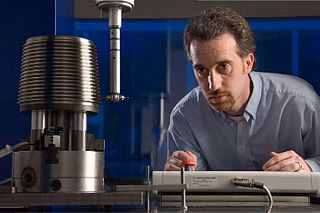
Mechanical engineering is an engineering branch that combines engineering physics and mathematics principles with materials science to design, analyze, manufacture, and maintain mechanical systems. It is one of the oldest and broadest of the engineering branches.

Quantum mechanics, part of quantum field theory, is a fundamental theory in physics. It describes physical properties of nature on an atomic scale.

The theory of relativity usually encompasses two interrelated theories by Albert Einstein: special relativity and general relativity. Special relativity applies to all physical phenomena in the absence of gravity. General relativity explains the law of gravitation and its relation to other forces of nature. It applies to the cosmological and astrophysical realm, including astronomy.
In measurement of a set, accuracy is closeness of the measurements to a specific value, while precision is the closeness of the measurements to each other.

Sir Joseph Whitworth, 1st Baronet was an English engineer, entrepreneur, inventor and philanthropist. In 1841, he devised the British Standard Whitworth system, which created an accepted standard for screw threads. Whitworth also created the Whitworth rifle, often called the "sharpshooter" because of its accuracy and considered one of the earliest examples of a sniper rifle.

Furtwangen im Schwarzwald is a small city located in the Black Forest region of south western Germany. It belongs to the district (Kreis) of Schwarzwald-Baar along with the two more important cities of Villingen and Schwenningen. The total population of Furtwangen was 9673 inhabitants on December 31, 2004. Furtwangen gained the right to call itself a city in 1873. The Breg is a small stream which, coming from the mountainous areas around Furtwangen, flows down through the inner city to the east. The Breg is one of the two little rivers which unite to form the river Danube.

Lebedev Institute of Precision Mechanics and Computer Engineering (IPMCE) is a Russian research institution. It used to be a Soviet Academy of Sciences organization in Soviet times. The institute specializes itself in the development of:
Kinematic determinacy is a term used in structural mechanics to describe a structure where material compatibility conditions alone can be used to calculate deflections. A kinematically determinate structure can be defined as a structure where, if it is possible to find nodal displacements compatible with member extensions, those nodal displacements are unique. The structure has no possible mechanisms, i.e. nodal displacements, compatible with zero member extensions, at least to a first-order approximation. Mathematically, the mass matrix of the structure must have full rank. Kinematic determinacy can be loosely used to classify an arrangement of structural members as a structure (stable) instead of a mechanism (unstable). The principles of kinematic determinacy are used to design precision devices such as mirror mounts for optics, and precision linear motion bearings.

John Williams Nystrom (1825–1885) was a Swedish born, American civil engineer, inventor, and author. He served as an assistant Secretary and Chief Engineer of the United States Navy during the American Civil War.
This is an alphabetical list of articles pertaining specifically to mechanical engineering. For a broad overview of engineering, please see List of engineering topics. For biographies please see List of engineers.
Geomechanics involves the study of the mechanics of soil and rock.
Applied mechanics is a branch of the physical sciences and the practical application of mechanics. Pure mechanics describes the response of bodies or systems of bodies to external behavior of a body, in either a beginning state of rest or of motion, subjected to the action of forces. Applied mechanics, bridges the gap between physical theory and its application to technology. It is used in many fields of engineering, especially mechanical engineering and civil engineering; in this context, it is commonly referred to as engineering mechanics. Much of modern applied or engineering mechanics is based on Isaac Newton's laws of motion while the modern practice of their application can be traced back to Stephen Timoshenko, who is said to be the father of modern engineering mechanics.

The Minerals, Metals & Materials Society (TMS) is a professional organization for materials scientists and engineers that encompasses the entire range of materials and engineering, from minerals processing and primary metals production to basic research and the advanced applications of materials.
This is an alphabetical list of articles pertaining specifically to Engineering Science and Mechanics (ESM). For a broad overview of engineering, please see Engineering. For biographies please see List of engineers and Mechanicians.

Manufacturing Engineering is a branch of professional engineering that shares many common concepts and ideas with other fields of engineering such as mechanical, chemical, electrical, and industrial engineering. Manufacturing engineering requires the ability to plan the practices of manufacturing; to research and to develop tools, processes, machines and equipment; and to integrate the facilities and systems for producing quality products with the optimum expenditure of capital.
This is an alphabetical list of articles pertaining specifically to civil engineering. For a broad overview of engineering, please see List of engineering topics. For biographies please see List of civil engineers.

Ultrasonic machining, or strictly speaking the "Ultrasonic vibration machining", is a subtraction manufacturing process that removes material from the surface of a part through high frequency, low amplitude vibrations of a tool against the material surface in the presence of fine abrasive particles. The tool travels vertically or orthogonal to the surface of the part at amplitudes of 0.05 to 0.125 mm. The fine abrasive grains are mixed with water to form a slurry that is distributed across the part and the tip of the tool. Typical grain sizes of the abrasive material range from 100 to 1000, where smaller grains produce smoother surface finishes.

Precision engineering is a subdiscipline of electrical engineering, software engineering, electronics engineering, mechanical engineering, and optical engineering concerned with designing machines, fixtures, and other structures that have exceptionally low tolerances, are repeatable, and are stable over time. These approaches have applications in machine tools, MEMS, NEMS, optoelectronics design, and many other fields.
Wang Daheng was a Chinese optical physicist, engineer, and inventor widely considered the "father of optical engineering" in China. He was a founding academician of both the Chinese Academy of Sciences and the Chinese Academy of Engineering. He was the founder of the Changchun Institute of Optics and Fine Mechanics, Changchun University of Science and Technology, and the Chinese Optical Society.










